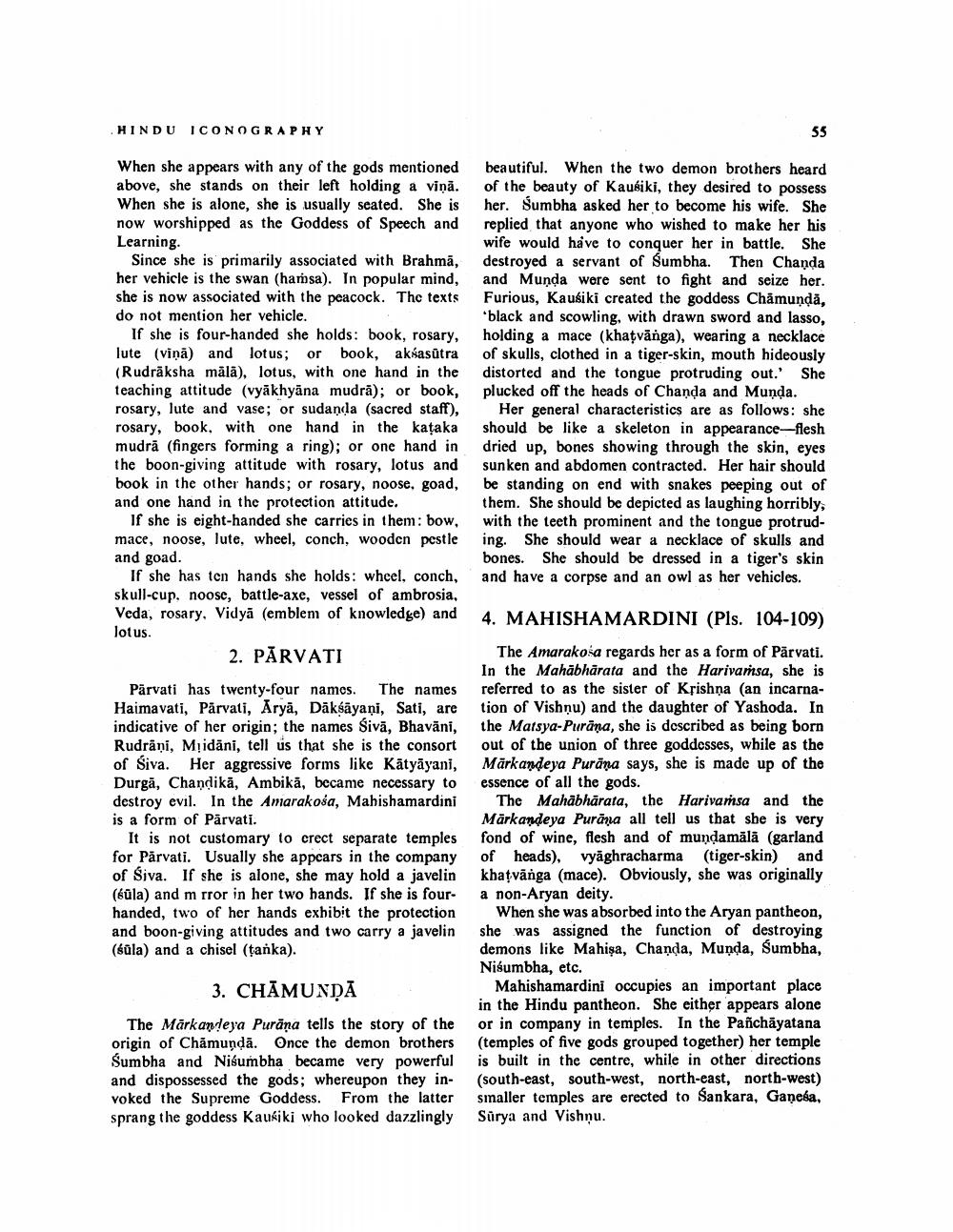________________
HINDU ICONOGRAPHY
55
When she appears with any of the gods mentioned above, she stands on their left holding a viņā. When she is alone, she is usually seated. She is now worshipped as the Goddess of Speech and Learning.
Since she is primarily associated with Brahmā, her vehicle is the swan (hamsa). In popular mind, she is now associated with the peacock. The texts do not mention her vehicle.
If she is four-handed she holds: book, rosary, lute (viņā) and lotus; or book, aksasūtra (Rudrāksha malā), lotus, with one hand in the teaching attitude (vyākhyāna mudrā); or book, rosary, lute and vase; or sudanda (sacred staff), rosary, book, with one hand in the kataka mudra (fingers forming a ring); or one hand in the boon-giving attitude with rosary, lotus and book in the other hands; or rosary, noose, goad, and one hand in the protection attitude.
If she is eight-handed she carries in them: bow, mace, noose, lute, wheel, conch, wooden pestle and goad.
If she has ten hands she holds: wheel, conch, skull-cup, noose, battle-axe, vessel of ambrosia, Veda, rosary, Vidyā (emblem of knowledge) and Jotus.
2. PĀRVATI
beautiful. When the two demon brothers heard of the beauty of Kausiki, they desired to possess her. Sumbha asked her to become his wife. She replied that anyone who wished to make her his wife would have to conquer her in battle. She destroyed a servant of Sumbha. Then Chanda and Munda were sent to fight and seize her. Furious, Kausiki created the goddess Chamunda, black and scowling, with drawn sword and lasso, holding a mace (khatvānga), wearing a necklace of skulls, clothed in a tiger-skin, mouth hideously distorted and the tongue protruding out. She plucked off the heads of Chanda and Munda.
Her general characteristics are as follows: she should be like a skeleton in appearance-flesh dried up, bones showing through the skin, eyes sunken and abdomen contracted. Her hair should be standing on end with snakes peeping out of them. She should be depicted as laughing horribly, with the teeth prominent and the tongue protruding. She should wear a necklace of skulls and bones. She should be dressed in a tiger's skin and have a corpse and an owl as her vehicles.
4. MAHISHAMARDINI (Pls. 104-109)
Pärvati has twenty-four names. The names Haimavati, Parvati, Arya, Daksāyaṇi, Sati, are indicative of her origin; the names Sivā, Bhavāni, Rudrāni, Midāni, tell us that she is the consort of Siva. Her aggressive forms like Katyāyani, Durgā, Chandikā, Ambikā, became necessary to destroy evil. In the Amarakoša, Mahishamardini is a form of Parvati.
It is not customary to crect separate temples for Pärvati. Usually she appears in the company of Siva. If she is alone, she may hold a javelin (6ūla) and mrror in her two hands. If she is four- handed, two of her hands exhibit the protection and boon-giving attitudes and two carry a javelin (śūla) and a chisel (tanka).
The Amarakośa regards her as a form of Pārvati. In the Mahābhārata and the Harivaṁsa, she is referred to as the sister of Kşishna (an incarnation of Vishnu) and the daughter of Yashoda. In the Matsya-Purāna, she is described as being born out of the union of three goddesses, while as the Märkandeya Purāņa says, she is made up of the essence of all the gods.
The Mahabharata, the Harivarsa and the Märkandeya Purāna all tell us that she is very fond of wine, flesh and of mundamålā (garland of heads), vyāghracharma (tiger-skin) and kbatvānga (mace). Obviously, she was originally a non-Aryan deity.
When she was absorbed into the Aryan pantheon, she was assigned the function of destroying demons like Mahișa, Chanda, Muņda, Sumbha, Nisumbha, etc.
Mahishamardini occupies an important place in the Hindu pantheon. She either appears alone or in company in temples. In the Panchāyatana (temples of five gods grouped together) her temple is built in the centre, while in other directions (south-east, south-west, north-east, north-west) smaller temples are erected to Sankara, Ganesa, Surya and Vishnu.
3. CHĀMUNDĀ
The Märkandeya Purāņa tells the story of the origin of Chămundā. Once the demon brothers Sumbha and Nisumbha became very powerful and dispossessed the gods; whereupon they in- voked the Supreme Goddess. From the latter sprang the goddess Kaukiki who looked dazzlingly




